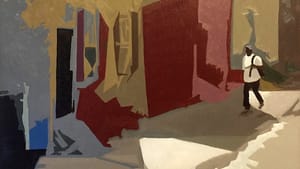Stay in the Loop
BSR publishes on a weekly schedule, with an email newsletter every Wednesday and Thursday morning. There’s no paywall, and subscribing is always free.
Shafts of light, slants of dark
The Cosmopolitan Club presents 'Nancy Herman: Small Oil Paintings'

Nancy Clearwater Herman is perhaps best known for her large, richly complex quilts and hangings. Her present Cosmopolitan Club exhibit shows another aspect of her art. The mostly small oil paintings on display here, some executed swiftly en plein air and some based on photographs of street scenes, range from urban to suburban to rural environments, all in the Philadelphia area.
The images represent all times of the day into the night, some with titles — 8:30 a.m., 5:00 p.m. The unifying element in most is the play of natural light on forms, either depicted directly or symbolically in swatches of a distinctive white.
Blurred lines
Herman’s palette is subtle and varied, but the ubiquity of white as a signature suggests it as the color from which all others emerge, the source that gives us sight and shapes not only the field of vision we inhabit but the riddling nature of perception. Everything is fully present but nothing is entirely stable, as if the objects depicted (human ones, particularly) are metamorphic. There’s more than a little of Edward Hopper here; what seems most immediate is also somehow unsettlingly other, or even absent.
A good example of this effect is The Ghost. The painting shows two figures seated on a park bench which seems to be in the process of being absorbed into the surrounding shrubbery. The most distinct figure is blocked from the waist up by an unfolded newspaper, her face invisible behind and effaced by a block of Herman’s white that seems to come from no source and have no objective referent.
The other figure is barely suggested, and the viewer is inclined to take it for the "ghost." However, the contrast between them suggests two shapes at different phases of appearance and disappearance, so we cannot clearly decide what is "actually" there.
A variation on the idea is The Face in the Window, whose pallor suggests an apparition rather than a figure. At the same time, it is the only face in the series in which we see discernible features.
Passers-by
The strollers, street-crossers, and otherwise occupied urban figures — for example, the woman in Feeding the Meter — have identity only through activity.
We see people in the street this way, as moving blurs, rarely coming into any kind of focus unless something brings them to our attention. Herman gives material objects—passing cars, the red bus in the picture of that title, the shadowed store bench in Feeding the Meter — the greater substantiality.
There’s a sharper edge to Herman’s work, too. The ironically titled Hope shows a man entering a street whose buildings, rendered semi-abstractly, seem on the point of collapse, if not self-cannibalization. A white wedge of light aims at a jagged red shape, descending toward it in a posture of attack.
Neither shape takes recognizable form and neither is wholly defined, which makes their generic menace all the spookier. The human figure seems oblivious to whatever may await him, but he also sports a white patch on his jersey. Is he predator or prey, or will he simply walk harmlessly by?
Herman suspends the choice or perhaps leaves it to the viewer to fill in the existential blank. Similarly but more directly, the question mark in Welcome? lets us decide what lies behind a door. Partly in sunlight and part in shadow, the door features a brass knocker whose animal head — dog, wolf, both? — faces us with an expression suggesting something besides hospitality.
How, then, shall we take Herman’s world, and our own? As her more rustic paintings suggest, the choice is ours in more ways than one. In these works, although the play of light and shadow is equally crucial and the observation sharp, there’s no menace.
It is certainly possible to suggest human expressiveness in landscape, as Charles Burchfield does. But Herman is not interested in using nature to editorialize. There are dark places and dangerous depths in it, to be sure. But real danger, she suggests, lies in the human heart.
What, When, Where
Nancy Herman: Small Oil Paintings. Through June 20, 2018, at the Cosmopolitan Club, 1616 Latimer Street, Philadelphia. (215) 735-1057 or cosclub.org.
Sign up for our newsletter
All of the week's new articles, all in one place. Sign up for the free weekly BSR newsletters, and don't miss a conversation.

 Robert Zaller
Robert Zaller